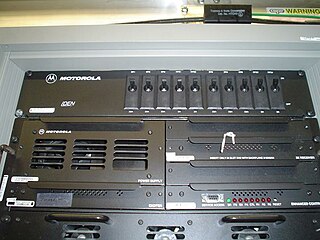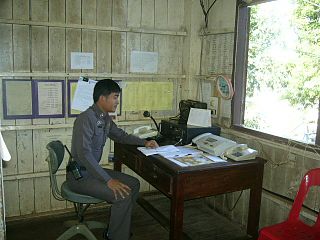Related Research Articles

Ultra high frequency (UHF) is the ITU designation for radio frequencies in the range between 300 megahertz (MHz) and 3 gigahertz (GHz), also known as the decimetre band as the wavelengths range from one meter to one tenth of a meter. Radio waves with frequencies above the UHF band fall into the super-high frequency (SHF) or microwave frequency range. Lower frequency signals fall into the VHF or lower bands. UHF radio waves propagate mainly by line of sight; they are blocked by hills and large buildings although the transmission through building walls is strong enough for indoor reception. They are used for television broadcasting, cell phones, satellite communication including GPS, personal radio services including Wi-Fi and Bluetooth, walkie-talkies, cordless phones, satellite phones, and numerous other applications.
Ten-codes, officially known as ten signals, are brevity codes used to represent common phrases in voice communication, particularly by US public safety officials and in citizens band (CB) radio transmissions. The police version of ten-codes is officially known as the APCO Project 14 Aural Brevity Code.

Base station is – according to the International Telecommunication Union's (ITU) Radio Regulations (RR) – a "land station in the land mobile service."
The Government Radio Network (GRN) is a network of various systems in place across Australia that enable statewide trunked radio communication. The network operates through inter-linked sites for government and public services such as police, ambulance, fire, or roads authorities which require such a system to function properly. The main aim of the GRN is to consolidate all resources into one network, ensuring greater coverage and reliability than if each department had its own independent communication system. The existence of the GRN also reduces the amount of government money and resources needed to maintain communication between units of emergency and public service branches. Last, it allows effective intercommunication among these services in times of national or state emergency for coordination of wide-scale actions.

A two-way radio is a radio transceiver, which is used for bidirectional person-to-person voice communication with other users with similar radios, in contrast to a broadcast receiver, which only receives transmissions.

Project 25 is a suite of standards for interoperable digital two-way radio products. P25 was developed by public safety professionals in North America and has gained acceptance for public safety, security, public service, and commercial applications worldwide. P25 radios are a direct replacement for analog UHF radios, adding the ability to transfer data as well as voice for more natural implementations of encryption and text messaging. P25 radios are commonly implemented by dispatch organizations, such as police, fire, ambulance and emergency rescue service, using vehicle-mounted radios combined with repeaters and handheld walkie-talkie use.
GSM frequency bands or frequency ranges are the cellular frequencies designated by the ITU for the operation of GSM mobile phones and other mobile devices.

The Joint Tactical Radio System (JTRS) aimed to replace existing radios in the American military with a single set of software-defined radios that could have new frequencies and modes (“waveforms”) added via upload, instead of requiring multiple radio types in ground vehicles, and using circuit board swaps in order to upgrade. JTRS has seen cost overruns and full program restructurings, along with cancellation of some parts of the program.

A trunked radio system is a two-way radio system that uses a control channel to automatically assign frequency channels to groups of user radios. In a traditional half-duplex land mobile radio system a group of users with mobile and portable two-way radios communicate over a single shared radio channel, with one user at a time talking. These systems typically have access to multiple channels, up to 40-60, so multiple groups in the same area can communicate simultaneously. In a conventional (non-trunked) system, channel selection is done manually; before use, the group must decide which channel to use, and manually switch all the radios to that channel. This is an inefficient use of scarce radio channel resources because the user group must have exclusive use of their channel regardless of how much or how little they are transmitting. There is also nothing to prevent multiple groups in the same area from choosing the same channel, causing conflicts and 'cross-talk'. A trunked radio system is an advanced alternative in which the channel selection process is done automatically, so as to avoid channel conflicts and maintain frequency efficiency across multiple talkgroups. This process is handed by what is essentially a central radio traffic controller, a function automatically handled by a computer system.
Diversity combining is the technique applied to combine the multiple received signals of a diversity reception device into a single improved signal.

A radio repeater is a combination of a radio receiver and a radio transmitter that receives a signal and retransmits it, so that two-way radio signals can cover longer distances. A repeater sited at a high elevation can allow two mobile stations, otherwise out of line-of-sight propagation range of each other, to communicate. Repeaters are found in professional, commercial, and government mobile radio systems and also in amateur radio.

Mobile radio or mobiles refer to wireless communications systems and devices which are based on radio frequencies, and where the path of communications is movable on either end. There are a variety of views about what constitutes mobile equipment. For US licensing purposes, mobiles may include hand-carried,, equipment. An obsolete term is radiophone.
LTR MultiNet Systems are APCO-16 compliant LTR Trunked Radio Systems and thus are mostly found in use as public safety systems. LTR MultiNet systems usually have one or more "status channels" that act like a control channel in a Motorola or EDACS system, however these channels can also carry voice transmissions simultaneously.
Specialized Mobile Radio (SMR) may be an analog or digital trunked two-way radio system, operated by a service in the VHF, 220, UHF, 700, 800 or 900 MHz bands. Some systems with advanced features are referred to as an Enhanced Specialized Mobile Radio (ESMR). Specialized Mobile Radio is a term defined in US Federal Communications Commission (FCC) regulations. The term is of US regulatory origin but may be used in other regions to describe similar commercial systems which offer a radio communications service to businesses.
ASTRO 25 is a generation of ASTRO digital two-way radio communications by Motorola Solutions. Motorola first introduced digital two-way radio in the U.S. in 1991 under the name ASTRO Digital Solutions.
Association of Public-Safety Communications Officials (APCO) International was founded in 1935.
StarCom21 is a statewide public safety trunked radio system in Illinois. Owned and operated by Motorola Solutions, the State of Illinois is a major partner in the system. It is used by all Illinois State Police posts as well as the Illinois State Toll Highway Authority (ISTHA) Maintenance and Police divisions.

Police radio is a radio system used by police and other law enforcement agencies to communicate with one another. Police radio systems almost always use two-way radio systems to allow for communications between police officers and dispatchers.

Nextel Communications, Inc. was an American wireless service operator that merged with and ceased to exist as a subsidiary of Sprint Corporation, which would later be bought by T-Mobile US and folded into that company. Nextel in Brazil, and formerly in Argentina, Chile, Peru, the Philippines, and Mexico, is part of NII Holdings, a stand-alone, publicly traded company not owned by Sprint Corporation.
The Alabama Regional Communications System (ARCS) is a radio/alert notification communications district with responsibility for providing user-based administration for operations and maintenance of the interoperable communications system that serves Calhoun County, Alabama and Talladega County, Alabama. The Motorola trunked radio system is licensed by the Federal Communications Commission (FCC) to operate on radio frequency spectrum in the 800 megahertz (MHz) public safety band.
References
- 1 2 "4.2.1 APCO Project 16," Arizona Phase II Final Report: Statewide Radio Interoperability Needs Assessment, (Phoenix, Arizona: Macro Corporation and The State of Arizona, 2004), pp. 42-43.
- 1 2 3 4 5 6 "Review of the APCO 'Project 16' Report," The California Highway Patrol Communications Technology Research Project on 800 MHz, 80-C477, (Sacramento, California: Department of General Services, Communications Technology Division, 1982,) pp. I-3 - I-9.
- ↑ APCO (March 1979). "900 MHz trunked communications system functional requirements development". United States Department of Justice.